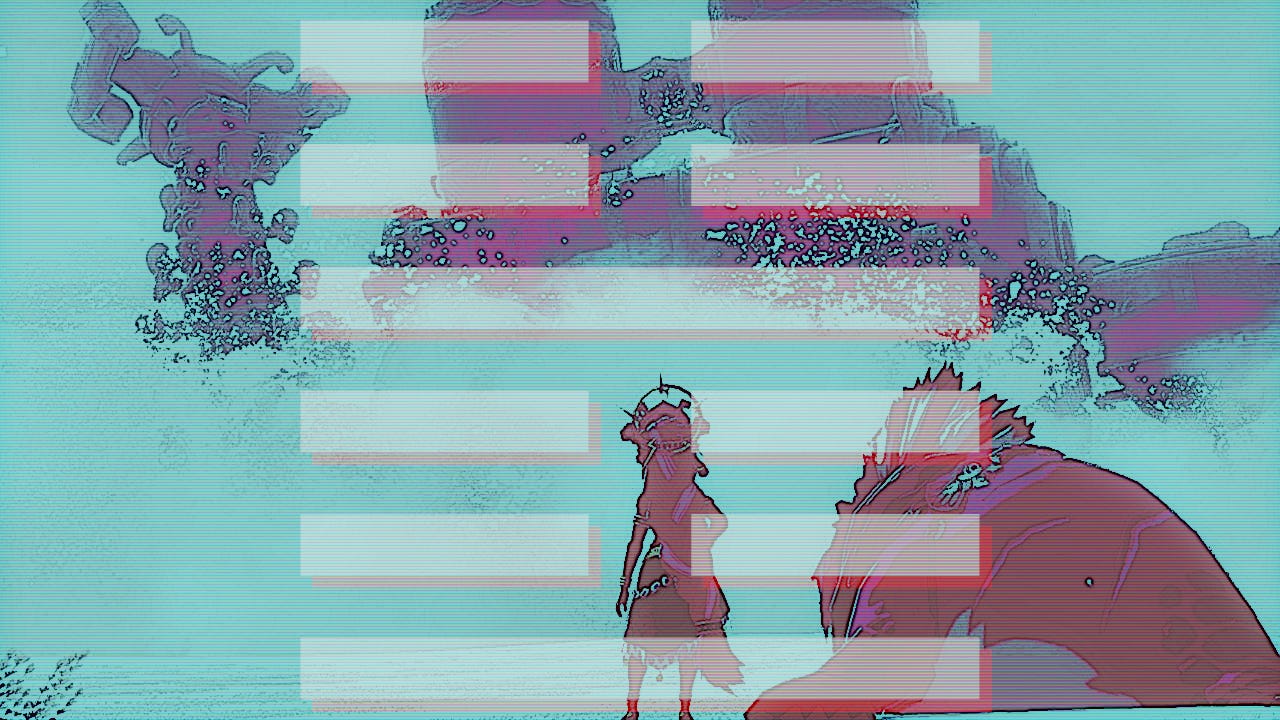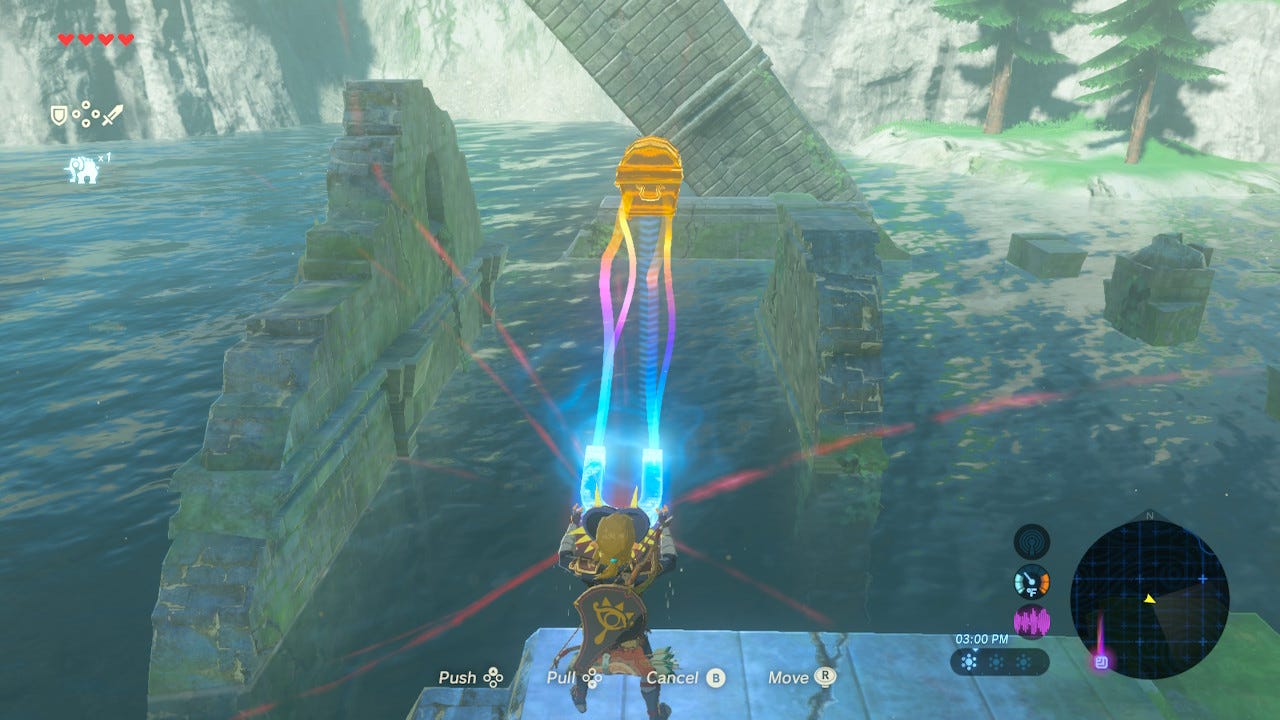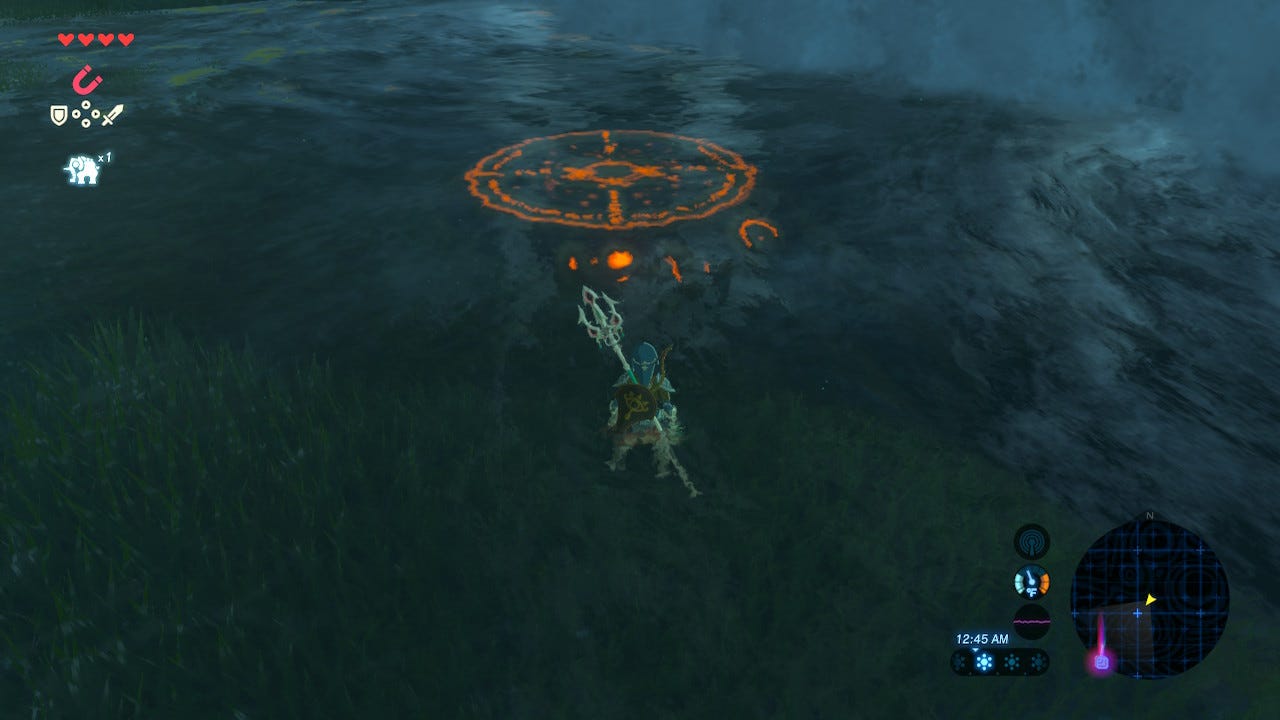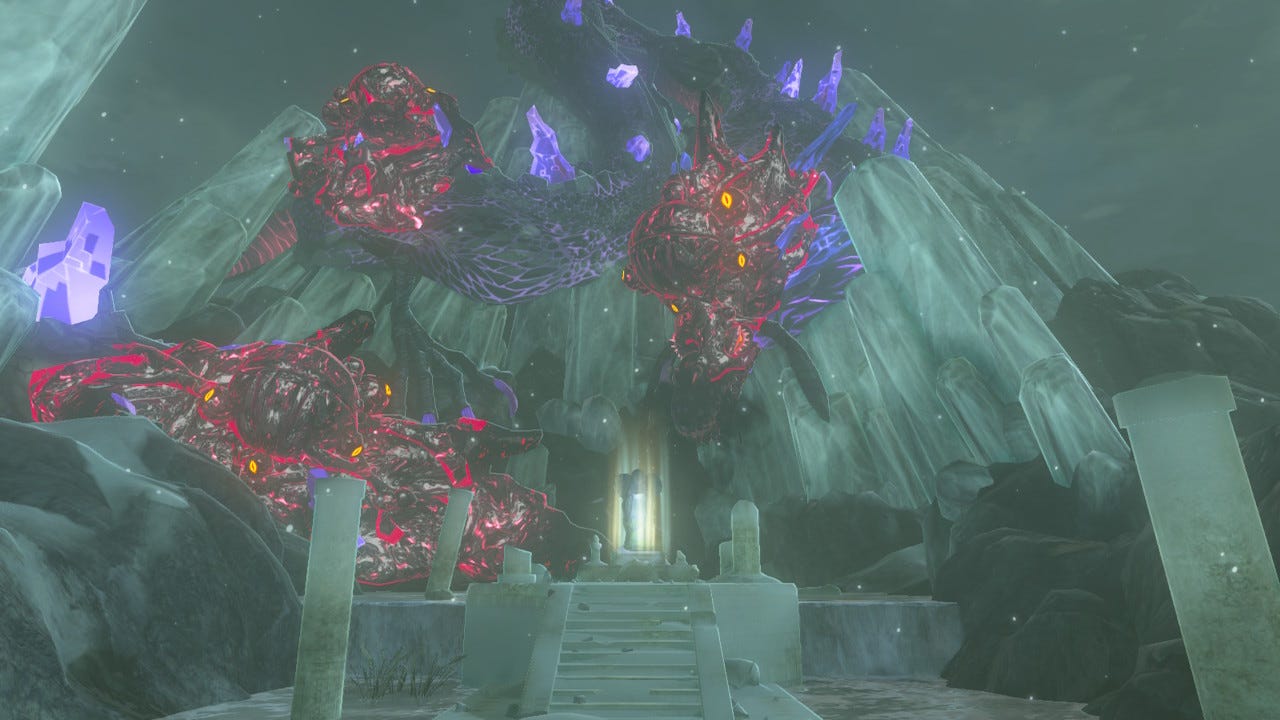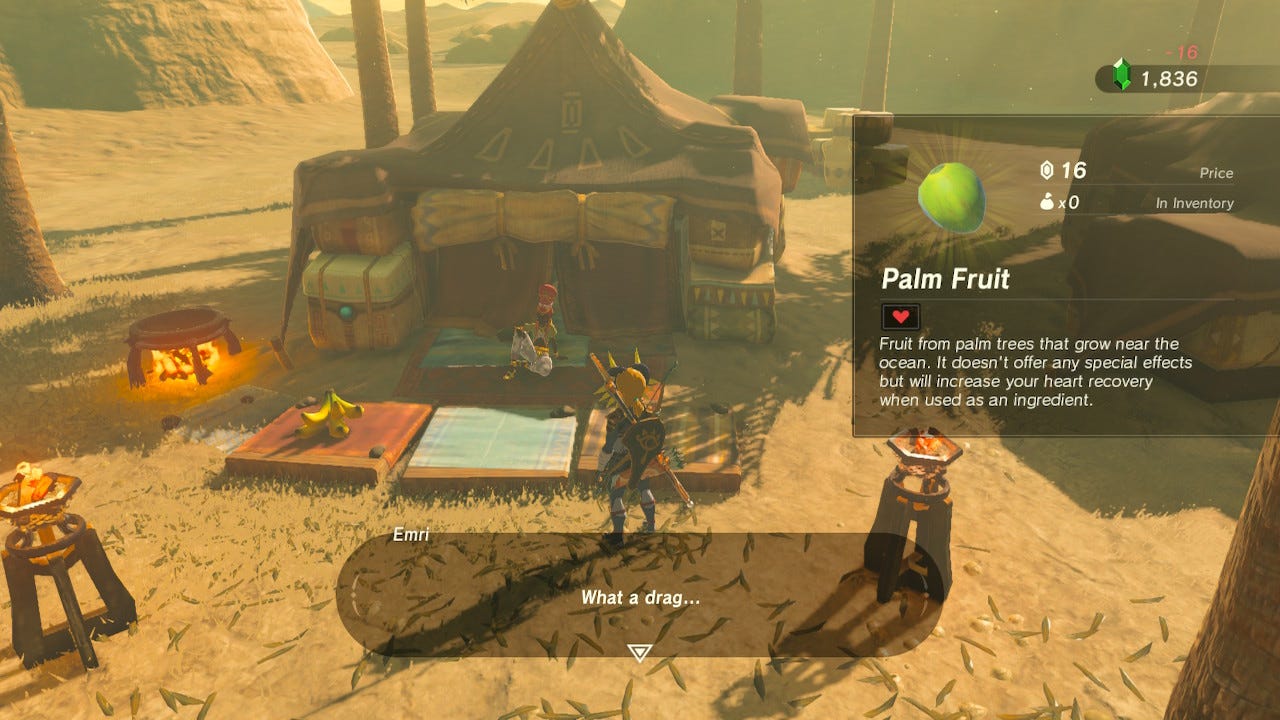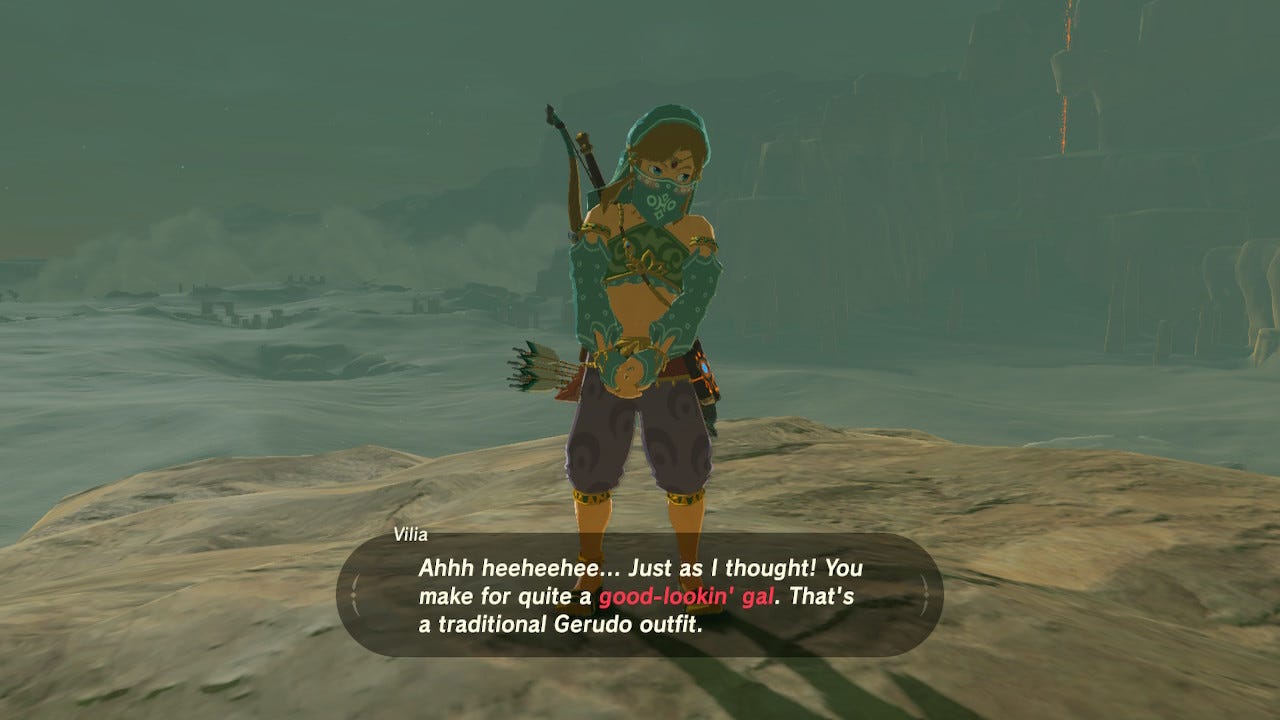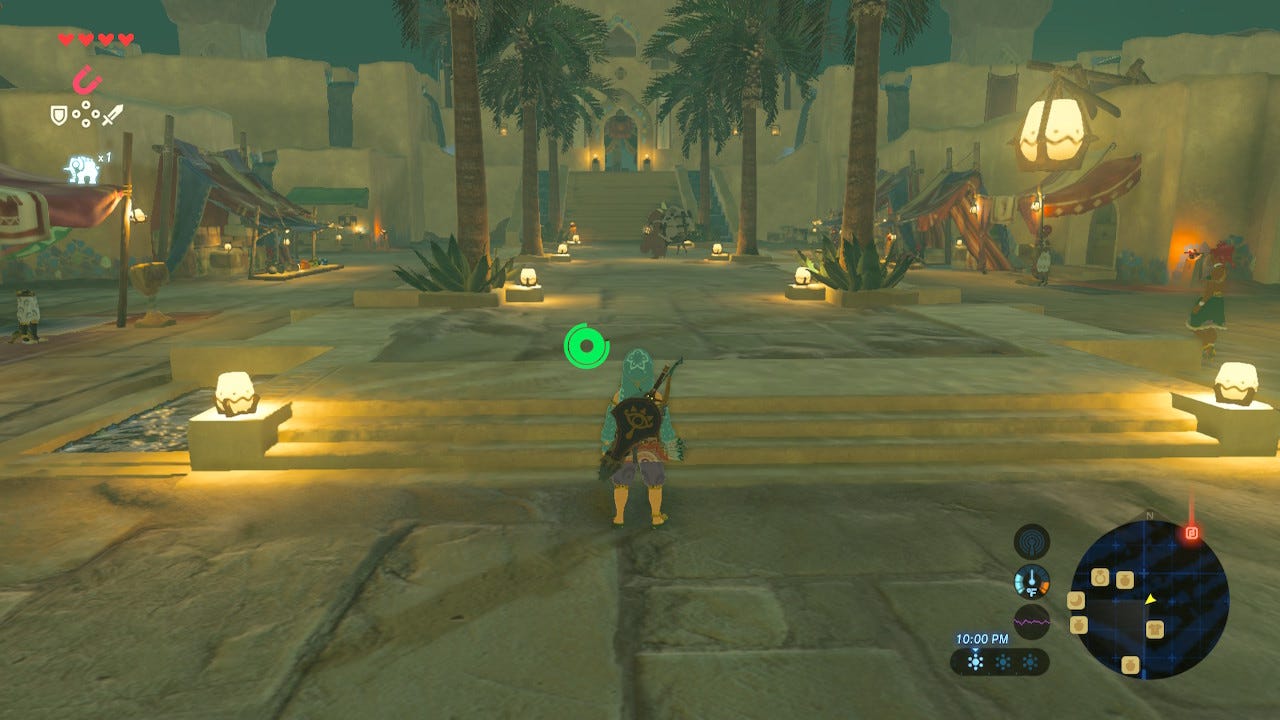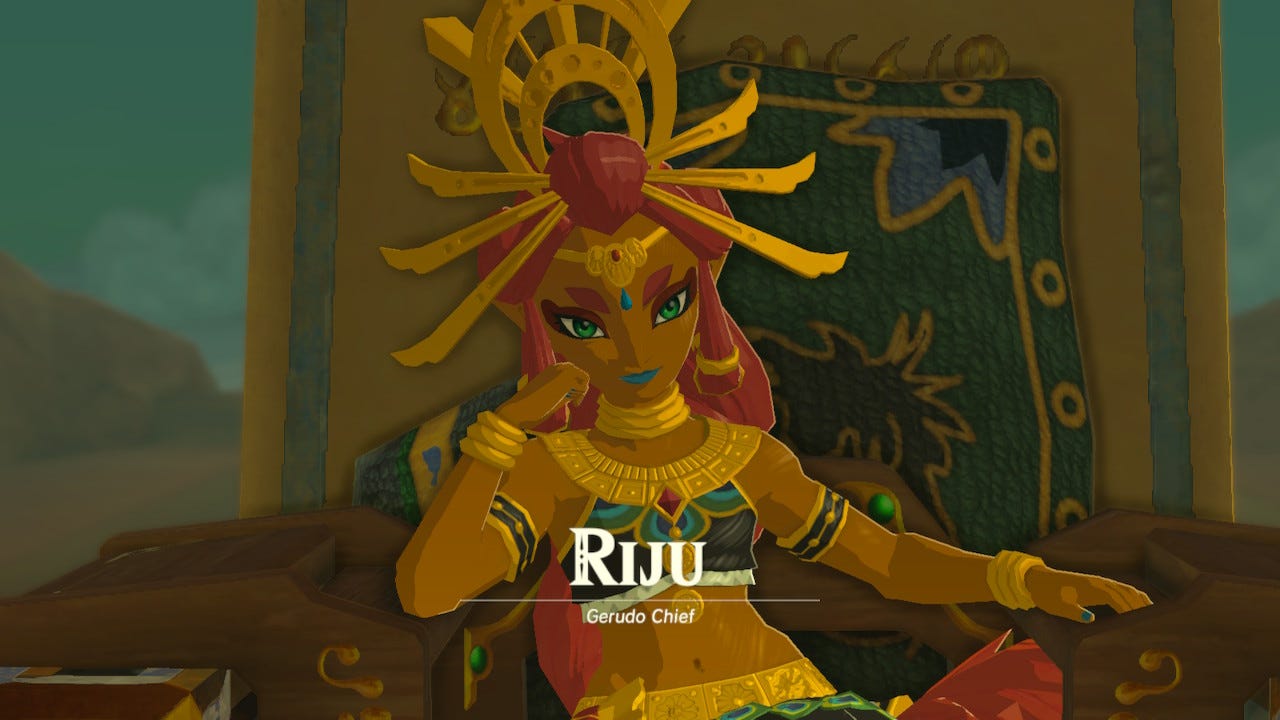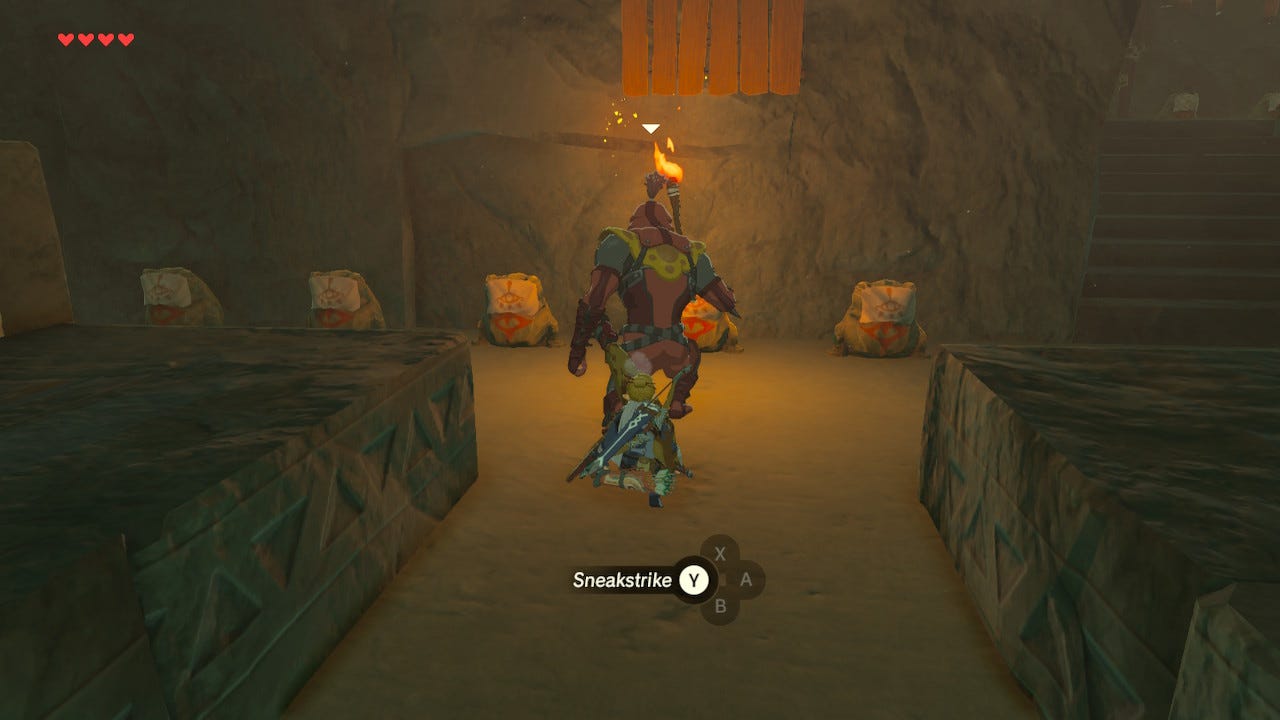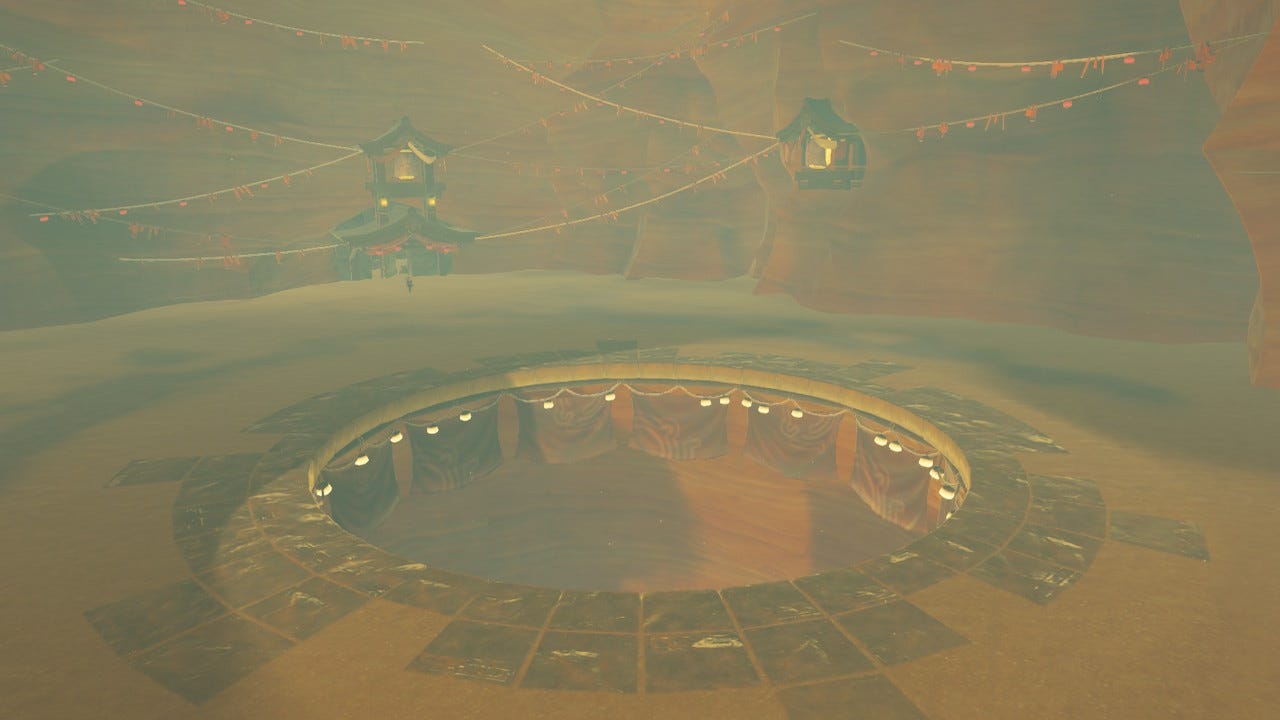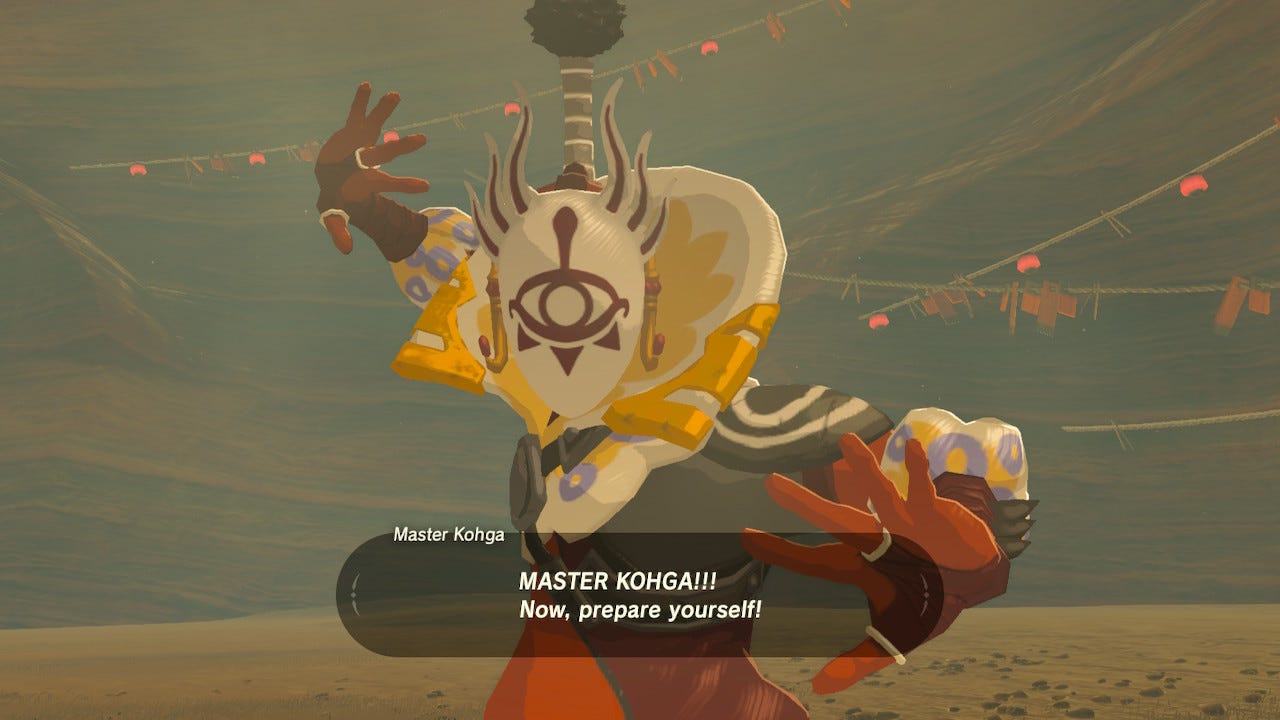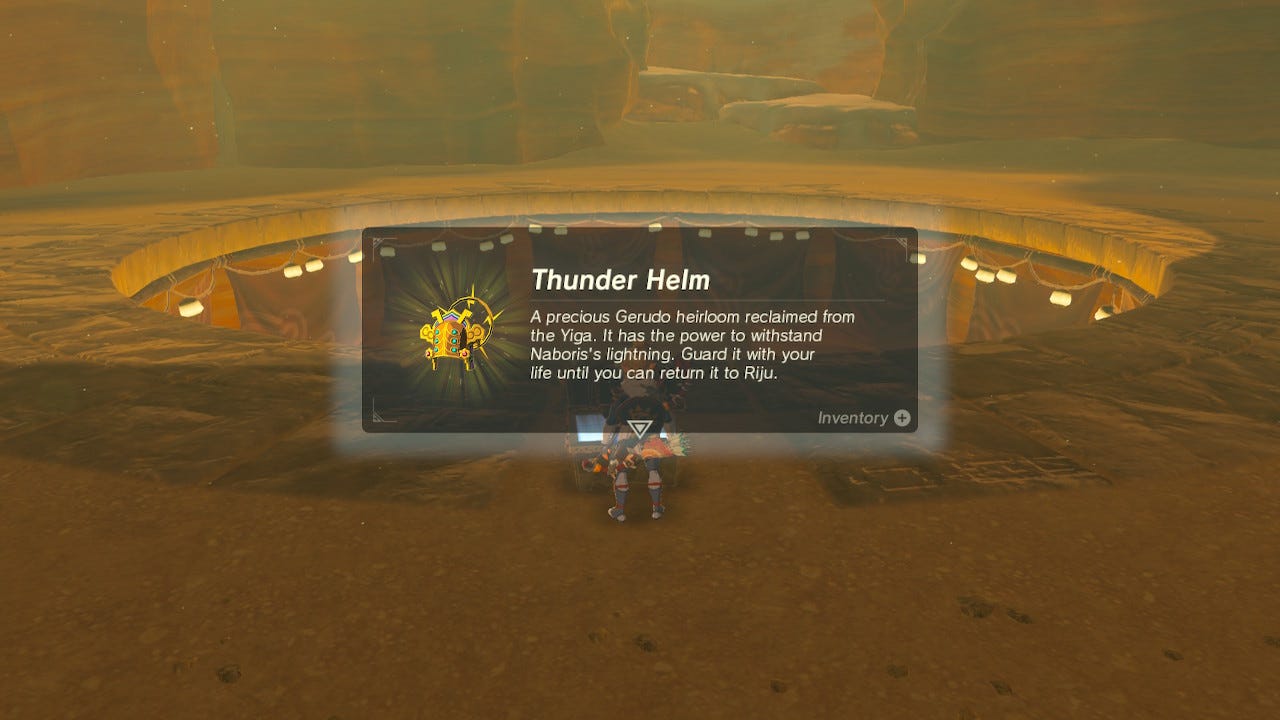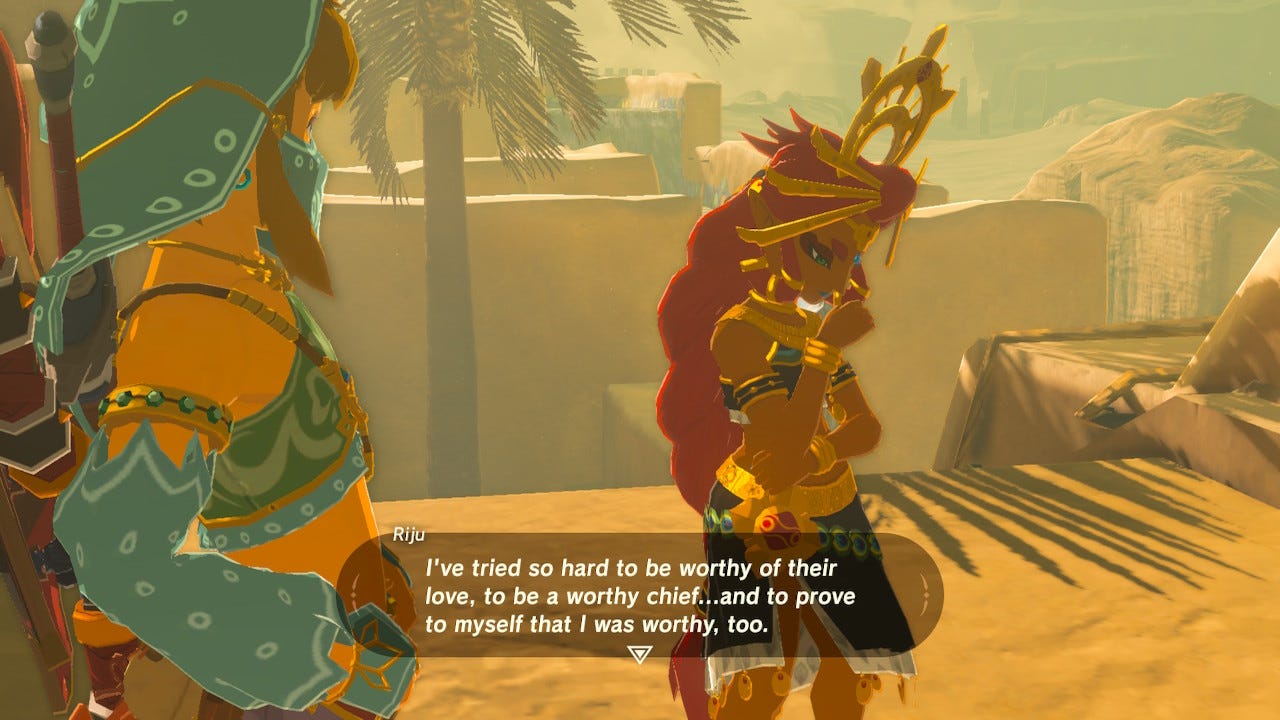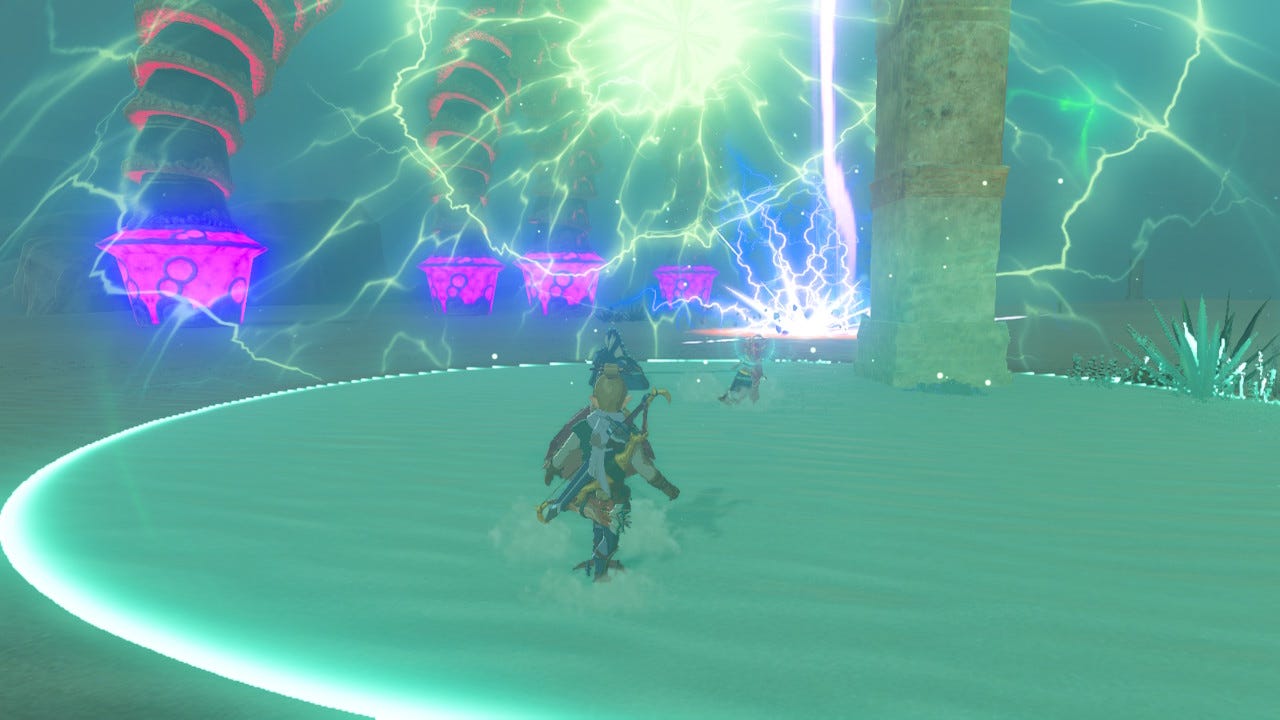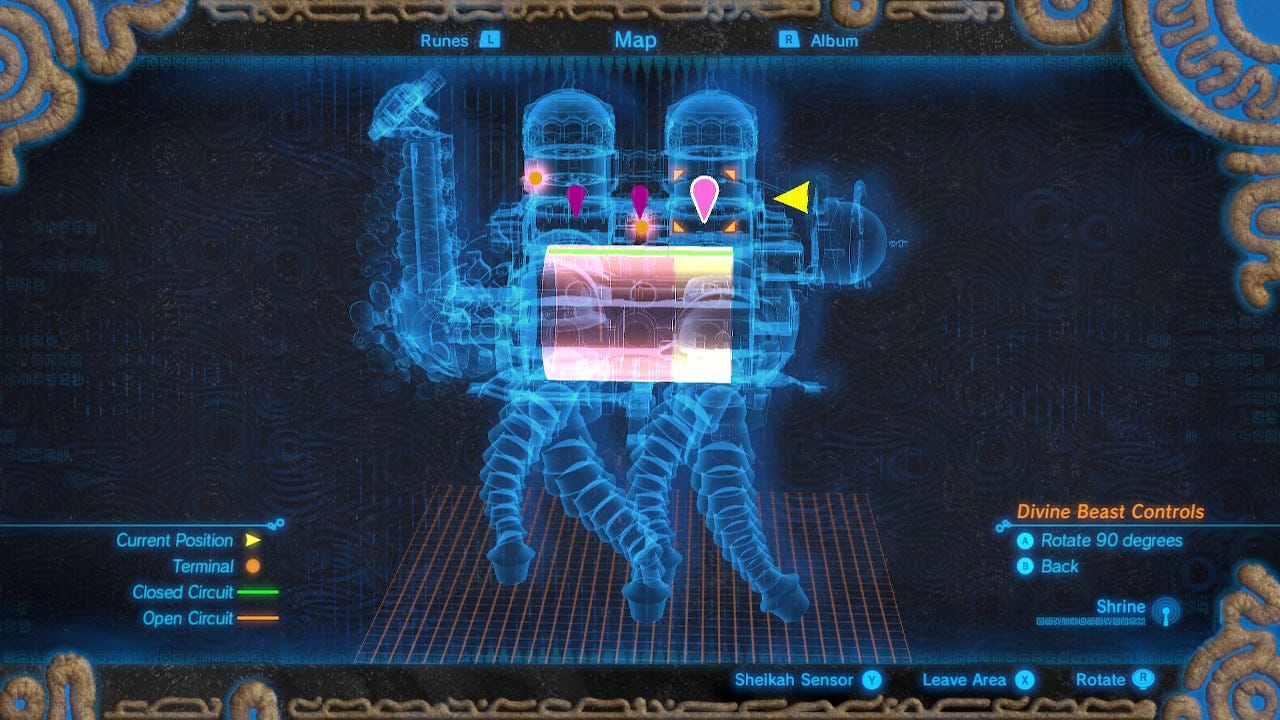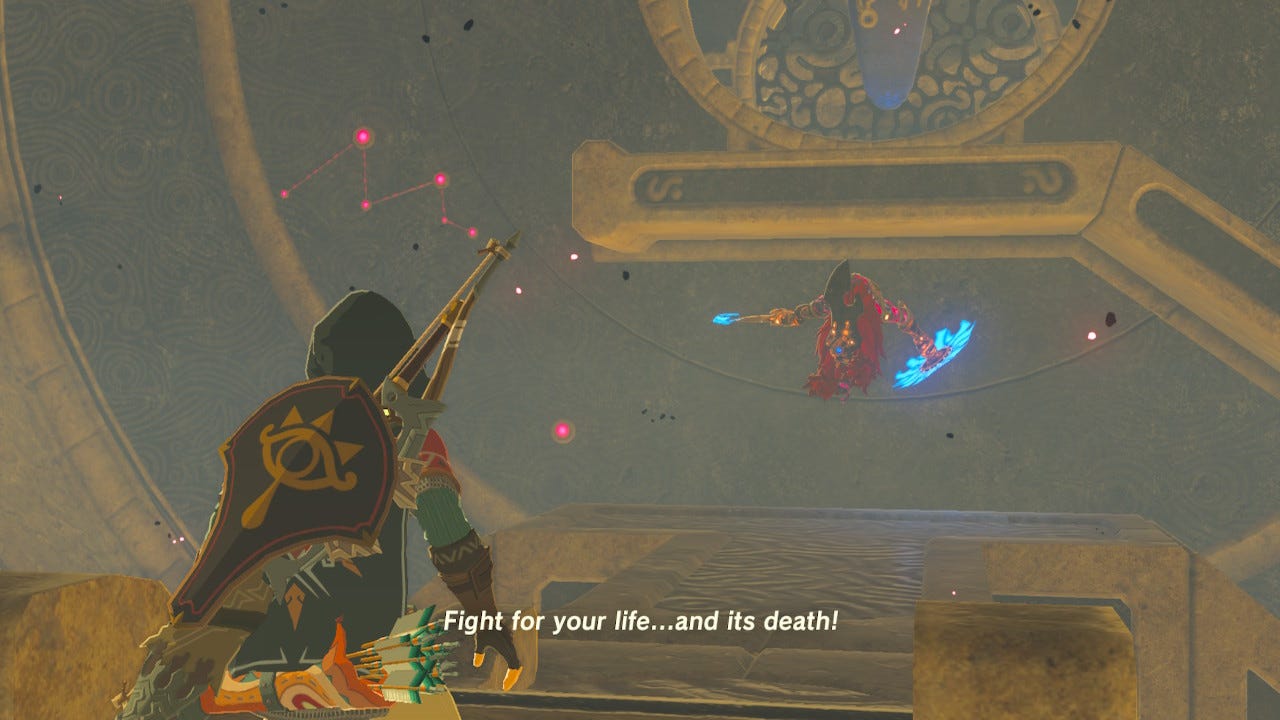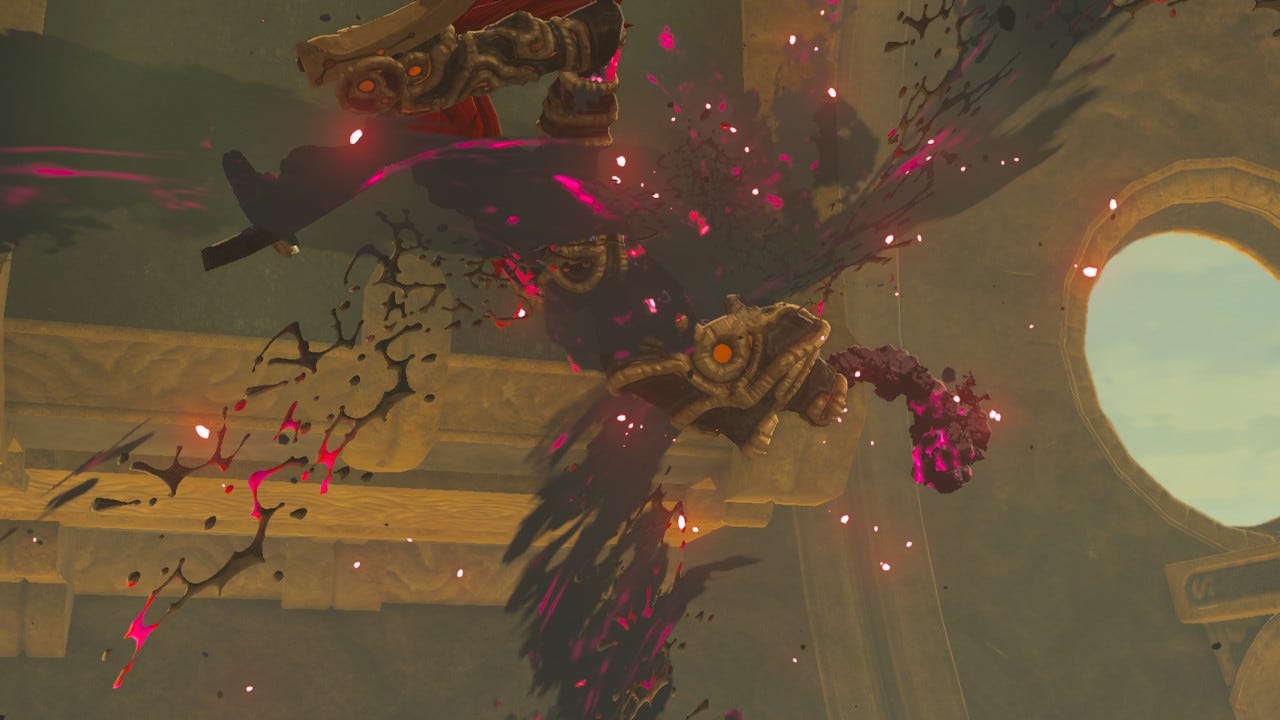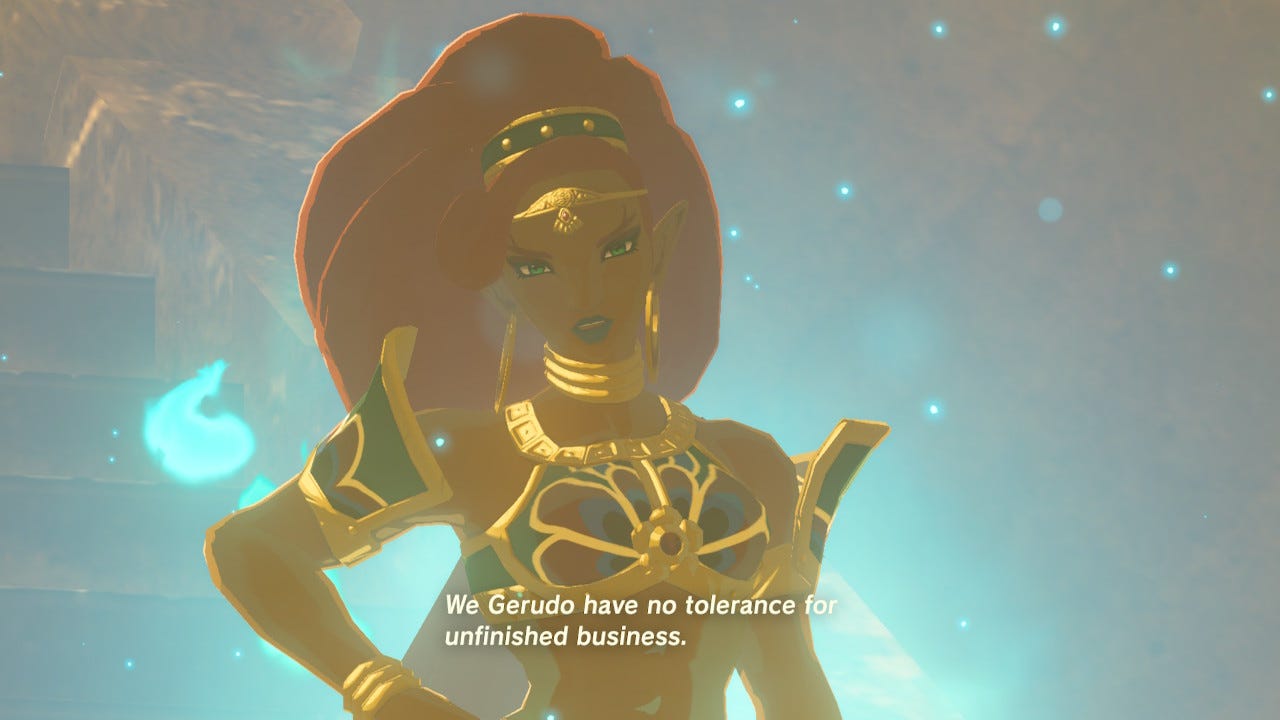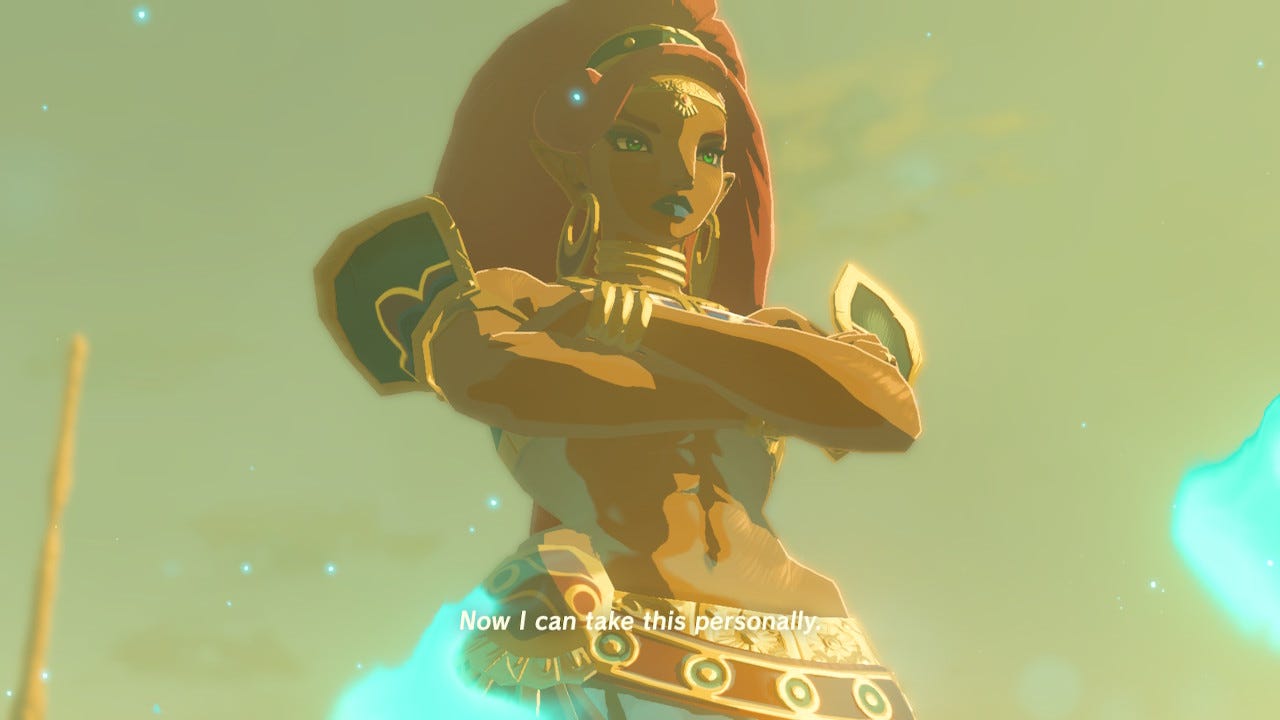Happy Tuesday, my friends!
There is a lot of ground to cover in this post, but I’m confident we’ll get through it neatly and cleanly. One of the themes of this post will be: “Appearances can be deceiving,” because while it appears that this is a post about the element of Thunder in The Legend of Zelda: Breath of the Wild, we will here be touching upon some of the deepest Mysteries at the heart of the Hylian Banishing Ritual (HBR).
WARNING! SPOILERS for The Legend of Zelda: Breath of the Wild and Tears of the Kingdom beyond this point!
As I mentioned in the post Opening the Gates, I was a bit surprised by my initial inclination to begin practicing this ritual in an arrangement that closely mirrors the traditional Lesser Banishing Ritual of the Pentagram, in that I was moved to begin in the East and move in a deosil direction. The reasons for doing so were also not dissimilar from the reasoning for the same decisions in The Golden Dawn; that is, their reason had to do with the central sacred importance of the symbolism of the Sun rising in the East. Similarly, I chose to begin in the East because of the central sacred importance of the symbolism of starting where the game clearly urges the player to start: With Divine Beast Vah Ruta. The plot-related reasons have a great deal to do with resolving the “unfinished business” between Link and Mipha, as well as the fact that, among the elemental “disasters” wrought by each of the four Divine Beasts, only Vah Ruta’s activities pose a threat to the greater Kingdom of Hyrule. That’s an important detail.
From there, I could either go North, to Vah Rudania, or I could go South, to Vah Naboris. I had to consider this decision in terms of the new understanding of the elements that was arising in my mind even as I was making those very same considerations. There was a relationship here to consciousness. In those terms, which progression made more sense: On the one hand, to move to the element of Fire, which—the reader may recall—we are “doubling up” with the functions of the element of Earth (largely for purposes of aiding the magician to psychically integrate working magic(k)ally with such a foreign elemental scheme), and largely for deeper reasons that form the hidden, central subject of this post. On the other hand, I could move to Thunder, the element I have identified as being the “solid” principle to the Hylians. Since I ended up deciding that the element of Fire is, in the symbolic context of this game and the HBR, the “lowest” element, closest to our Earth plane, In decided it would make the most sense to go South from here.
Before making the trek, there’s an errand or two to run around Zora’s Domain for the sake of preparedness, one of which gives me the perfect opportunity to introduce another of the many examples of the “hidden central Mystery” of this post, one to which I have alluded ceaselessly almost since the beginning of these writings nearly two years ago: “Turning Things Around.”
A principle that comes up in several specific contexts in different Left Hand Path schools is that of “reversal” or “inversion,” of causing various natural processes to flow in the reverse of their usual courses. One example from sex magic(k) practices would be the retention of semen, whereby instead of ejaculating during orgasm, the yogi manages to hold the semen inside the body, supposedly causing the energy that went into making it to flow back up the central channel of the spine—the “sushumna”—from whence it came.
This is illustrated in-game by a hidden power of the Zora Chestplate that I have thus far neglected to mention: The fact that it grants Link the amazing (and fun) ability to swim directly up waterfalls. It becomes very important.
After defeating Waterblight Ganon to fully free and activate Divine Beast Vah Ruta, my first order of business was to put that ability to use to travel up to Toto Lake so I could use Magnesis to fish the Zora Helm out of the water—notably, in the flooded ruins of what appears to be yet another cathedral—thus completing the Zora armor set. It’s not for nothin’—each set piece grants Link a bonus to Swim Speed, and that’s honestly the only way to swim in a manner that utilizes your Stamina gauge efficiently. You also get a “Spin Attack” for Link to carry out in the water, which…I’ve…never used.
Next, Dagah Keek Shrine is right next to the city of Zora’s Domain, and especially this early in the game, it’s a good idea to run through any Sheikah Shrines that make themselves even remotely convenient so Link can get enough orbs to pull The Master Sword. There’s a quest associated with the Shrine called “The Ceremonial Song” (wink), where Link hears some Zora kids singing a song near Mipha’s statue which provides clues for completing this quest. A girl tells Link to speak with Trello up on the Western bridge out of town for more information. Trello turns out to be fretting about a missing ceremonial trident needed for some kind of ceremony (the one the kids were singing about). Down in the waters below is the trident, which Link can reach using both Cryonis and Magnesis. Once he retrieves it, Trello doesn’t seem to care for it anymore, and tells Link he can perform the ceremony himself.
The “ceremony” turns out to involve going to the top of a nearby fountain and diving off of it, executing a dive attack with the trident that hits a glowing, circular platform at the bottom of the waterfall; it’s high enough that if you do it without using the paraglider, Link will die from the fall. If he has it, Mipha’s Grace will kick in and not only replenish his hearts, but give him more extra yellow hearts than he currently has normal red ones. This is why I do this after Vah Ruta.
Next, it was time to start heading South and thinking about how I was going to approach Vah Naboris. My next destination along the way was to activate Lanayru Tower to reveal its corresponding section of the map, then I was off to Mount Lanayru.
I’ve already written about this quest in the post The Wisdom Eye, which includes a pretty cool account of a rather wild set of synchronicities that occurred one night during my first Initiatory playthrough. I’ll also be discussing the symbolism of that quest in greater depth in the upcoming post about trinity, the Triforce, and the three dragons. Briefly, however, there are three dragons roaming the skies of Hyrule that most people can’t see or interact with, but Link can. Actually, at the beginning of the game, there are only two, because Naydra—the dragon of Ice who also corresponds with the Triforce of Wisdom—is still corrupted by Calamity Ganon’s Malice, covered in magenta sludge and mutant eyes. It’s up to Link to follow the exhortations of Goddess Hylia emanating from her shrine where Naydra lays huddled and coiled about Mount Lanayru, cleansing the Malice and freeing Naydra. That feels good. Plus, there’s another Sheikah Shrine here, so…
Now there were choices to be made—and why? Because Divine Beast Vah Naboris is widely considered the most difficult Divine Beast to cleanse, mainly because of how much skill is required to win the battle against Thunderblight Ganon. This ends up fitting very well with the esoteric symbolism of this leg of the game.
There are a number of ways I could mitigate this that would each involve doing some extra work before heading into the Gerudo Desert:
I could get The Rubber Armor set, which reduces Shock damage and comes with a set bonus that makes Link Unshockable (meaning he can’t be jolted into dropping his weapons and/or shield). Two problems with that. One is symbolic: For those who know, the Rubber Armor set is a gimp suit. It’s one with a mask fashioned to resemble the fish at the center of Zora’s Domain, which has a lot of symbolism not only for Link, but—rather unsettlingly—for me, as well. I may tell that story some day, but I’m not sure. Anyway, who wants to be Mipha’s gimp? No thanks. Also, upgrading the armor to get the Unshockable bonus means getting it to Level 2, which for me, means going out of my way, not least to awaken another fairy. No time to bother with all of that.
I could also activate Faron Tower—rather conveniently, while getting two pieces of the Rubber Armor nearby—and collect some Hearty Durian from the mesa beside it. This is the food with the highest yellow heart bonus in the game. With a full load of 5 cooked Durian, Link can max out his heart meter, even at the very beginning of the game. This would definitely be a way to help ensure victory against Thunderblight Ganon. It’d be a cheap way, but it’d be a way.
I decided to challenge myself and do neither. I decided to just head right into Gerudo and give Thunderblight Ganon my best shot; if I really couldn’t take him down, I could always grab some Hearty Durian later.
But I’ll be damned if I do this in that gimp suit; it’s not happening.
The journey to the Gerudo Desert included the completion of 5 Sheikah Shrines along the way, which got me closer to pulling the Master Sword, but did nothing else of any use to aid me in my upcoming task; the Stamina is good to have, but won’t help me win my fight with Thunderblight Ganon. The journey took me a while, and it provides a good narrative opportunity to shift the focus to the theoretical side of this post.
Catch You On The Flip Side
The concept of “reversal” is a fairly deep example of the Mysteries of the Left Hand Path; it’s one I’ve known about, on a basic level, for about 20 years. I am still uncovering new layers of the Mystery to this day. We’re about to explore a region of the game that fully embodies this principle in numerous ways—some of which provide keys to understanding the HBR as a gestalt—not only a ritual, but an entire miniature paradigm, including philosophical, technical, and concrete elements.
We’ll be transitioning from one rich and consistent metaphor for The Abyss (as well as the Sephirah of Binah)—”waters” or “seas”—to another: Desert reaches. It is illustrated beautifully in the Thoth tarot’s version of the 3 of Disks:
This involves some interesting symbolic shifts. As we explored in the previous post on the element of Water, the city of Zora’s Domain is circular in shape, which carries important symbolic meaning connecting it with Goddess symbolism—something I have pointed out in past posts, as well. It’s a circular city associated with water, which is cool and moist.
By contrast, the city of Gerudo Town is a square-shaped, walled city situated in the dry, hot (at least during the day) Gerudo Desert.
Thinking back to my days as a Theosophist, I remember that the human constitution was “broken up” in the Theosophical model into 7 separate “principles,” each corresponding roughly to one of the 7 chakras, which were further sub-divided into sets represented by geometric figures:
The “Upper Triad,” represented by a triangle, and
The “Lower Quaternary,” represented by a square.
Lastly—and I may be pulling this out of my ass—but I think the whole was represented, as in Jungian theory, as a circle.
In this scenario, Zora’s Domain, being circular, represents the greater whole at work here. For those familiar with Thelemic symbolism, the particular Goddess represented by this circle is, I think, Nuit. In the symbolism of the Temple of Set, the inverted Pentagram of Set is depicted inside of, but importantly, not touching, a circle which represents nature. The meaning is that a Setian moves to separate oneself from the greater matrix of nature. This symbolism carries over to Zora’s Domain, and to the element of Water as a whole: This area represents the environs of The Abyss.
If the element of Water represents the wide, undifferentiated field of the subconscious, which roughly correlates with The Abyss as well, then the movement to Thunder is the awakening of awareness, and its coalescence into discrete units. Where water molecules readily bond together and form a cohesive whole, grains of sand remain separate from one another, even as they grind each other down over the eons into dust.
Gerudo Town, Thunder, and Vah Naboris represent the current of electricity looping back upon itself, symbolizing self-consciousness, and then crystallizing into a stable form (the square/the ego).
However, there’s a plot twist: In traditional symbolism, this principle is typically male. In Hinduism, for example, it is cognate with Shiva, who, while technically androgynous, is generalized as male. In Egyptian religion, it was (in one aspect) Set, also a male. In Tibetan Buddhism and various indigenous shamanistic traditions in that region of the world, it’s Shiva/phurba/Garuda, with symbolism that is still pretty much masculine. In terms of Thelemic deities, this is the “Hadit” to Water’s “Nuit.”
All throughout the book Nightside of Eden, Grant also makes reference to the identification of thunder with the Hebrew letter Aleph, and thus the Fool card, who is also traditionally male. Incidentally, this string of identifying symbols also includes the swastika, and we’ll be coming back to that.
Despite all of this masculine symbolism that is traditional of this principle, the city of Gerudo Town is populated entirely by women—and in order to enter it, Link must even dress up as one. This leg of the game is one of the reasons Breath of the Wild is beloved by many trans gamers: The way the game treats the scenes related to this is extremely fun, lighthearted, and inclusive. Many trans and non-binary people report that it makes them feel seen. I think it may even be considered an egg-breaker for some. I could definitely see that being the case. It’s not the only example of Nintendo showing its support for LGBTQ+ people in this game, and we’ll be exploring others eventually.
In addition to being almost all-female, the Gerudo race has another interesting feature in light of the Thelemic contexts drawn upon in this work: They’re all redheads.
My, how very “Babalon.”
This presents what only appears to be a conundrum until we remind ourselves of the territory we’re treading with this ritual:
The very borderline between “Universe A,” or the front side of the Tree of Life, and “Universe B,” or the back side. It’s not one or the other: The border between the two runs right through the middle of this ritual—symbolically, theoretically, and actually/magic(k)ally. The proverbial “crossover” happens right in the midst of it. This comes with no end of topsy-turvy consequences, because this “border” is the point at which non-manifestation becomes manifestation—which means it’s the point at which the infinite is forced to cram itself uncomfortably into the finite. That is, the circle enters the square.
It’s all very “warped” and “twisted.” One characteristic feature of the resulting landscape is a pervasive ambivalence, where things are neither-this-nor-that, but somehow both things, even when it comes to opposing principles. Thus, we have Babalon—typically associated with watery symbols like the Holy Grail, a chalice, as well as the process of the Adept’s shedding of “the Blood of the Saints,” an inherently watery, Nuit-oriented process of ego dissolution—woven deeply into the symbolic fabric of a zone that otherwise represents principles largely opposing that of Babalon.
This is Universe B. This is The Abyss. This is also The Supernal Realm. It is very jarring until one gets used to it, and that’s probably even true if one is adequately prepared for it.
The presence of this border right through the heart of the HBR—or, viewed another way, this situation of the HBR itself at the very threshold of the Abyss—is the explanation for the complicated relationship between the Hylian elements of Fire and Thunder and the real-world element of Earth: That’s all a part of the same “veil” or “threshold” around which the HBR is snugly wrapped. The way contrasting principles merge and wind together in confounding ways, like an Escher sketch rendered completely abstract, is an essential part of this territory. It’s also a big part of how and why the ritual works the way it does.
In ‘Til Daath Do Us Part, I quoted a passage from page 250 of Nightside of Eden—stopping just short of the following words:
According to the ancient occult lore there is but one method of penetrating the mysteries of the Meon, and that is by a reversal of the magical invocations which one would normally use in connection with Universe ‘A’. Frater Achad in recent times used this formula of reversion in a qabalistic sense and it enabled him to unravel many mysteries in The Book of the Law. It yielded the magical key that Aleister Crowley had searched for in vain, yet Crowley had intuited the correct formula when he declared: ‘I recognize magick as concerned to reverse any existing order’.
Michael Bertiaux has carried this idea a stage further than both Crowley and Achad. Bertiaux suggests that ‘Choronzon might be thought of as one of the approaches to Universe ‘B’.
It may, indeed, have been through this tunnel to the ‘other side’ of the Tree that Crowley acquired the elements of ‘evil’ that were to wreck his work in the Outer and make his books abhorred by those who did not understand the singular connection between the two universes.
pp. 250-251
For those interested in some related reading, there’s a great post at Thelemic Union called AL and LA: Thelema and The Death of God that examines the “magical key” mentioned above, what it was that Frater Achad found, and its larger theological implications as they relate to Nietzche’s declaration of God’s timely demise. It’s highly relevant to the bigger picture.
The mechanism of “reversal” described above is employed and reflected in the HBR in numerous ways; this rendering of the principle of Set/Hadit/Shiva/Thunder in feminine as opposed to masculine form is one. The “splitting” of the “Promethean element” into Fire and Thunder, with the “weaving” of Earth qualities into each one in different ways, is another. The placement of Water in the East, with Air in the West—a reversal of the traditional LBRP attributions—is another. There are more, but this is another key to the deceptively simple face of this ritual.
Grant continues:
The 31st Path is divided between the powers of Fire and Spirit, and the 32nd and final path is divided between the powers of Earth and Saturn.
In the 31st tunnel the powers of Fire and Spirit resume the formula of the Fire Snake, which is that of Spirit/Matter in the macrocosm and Choronzon/Woman in the microcosm. In other words, the essential forces of darkness (matter) are activated in the macrocosm by the element of Spirit, and in the microcosm they manifest in the woman who embodies the Fire Snake. The mechanics of this formula have been explained in my Typhonian Trilogy.
pp. 251-252
In one way of understanding things, this ritual inhabits the very threshold between the 31st and 32nd paths as described above—it spans them both, and thus it joins them together even in ways that seem improbable or impossible.
There are important consequences of this that we’ll be exploring as we loop back into theory later on; for now, however, let’s continue our journey into the Gerudo Desert.
Did You Say “Crossing?”
Between the edge of Gerudo Canyon and the walls of Gerudo Town stretches a sandy waste—with Kara Kara Bazaar situated around an oasis about halfway between the two. It’s an essential waypoint on Link’s journey, and it’s one that takes me back to my roots.
One of the fun little “easter eggs” in the game that I always thought of as particularly indicative of the “Setian” nature of this terrain is the presence of Hydromelons—an in-game version of watermelon, which is sacred to Set. There’s a woman selling some here, and it’s a good idea to stock up because cooking Hydromelons gives Link a temporary resistance to the daytime desert heat. I chuckle at the vendor’s comment as Link empties her inventory of any given item. It’ll make sense later.
I always found this part tedious; Link has to finish crossing the desert to the outskirts of Gerudo Town, then he needs to talk to some incel standing outside and trying to sneak into town, who tips him off that some man made it into town by dressing as a woman, and he’s now hanging out at Kara Kara Bazaar and possibly selling women’s clothes to interested men.
For backstory: The Gerudo are almost all women. Only one in one hundred births or so ends up being male, and this person is typically crowned King of the Gerudo. As it happens, Ganondorf—the man behind the game’s main foe, Calamity Ganon—was one such Gerudo King. This brings great shame upon the Gerudo’s reputation. They thus live in a closed female society in the desert they call home. Given the hardships of desert living and their need to be self-reliant, the Gerudo are renowned for their strength. Most of them are warriors, and the Gerudo were probably modeled in part after the Amazons of ancient legend in the real world.
Given the rarity of Gerudo males, it’s fortunate that Gerudo women are genetically compatible with Hylians; as such, it’s customary for a Gerudo woman to leave town upon coming of age, to set out into the world to find herself a Hylian voe (voe is “man” in the Gerudo tongue, while “vai” is “woman”). Otherwise, it’s women only—with the notable of exception of the Gorons, from up North, who reflect the Gerudo in that all of them are male. We’ll get into their nuance in the appropriate post.
All of this necessitates that Link now travel back to Kara Kara. Fortunately, he can sneak up on a Sand Seal and ride it back; on top of that, since there’s a Sheikah Shrine right outside the town wall, he can warp right back once he’s finished there.
I always chuckle at this part of the game, especially with the prevalence of the Babalon and Set symbolism involved here. Why? Because of how it ties into my pseudonym, “Gogo Bordello.”
Link meets up with a beautiful man (as suggested by dialogue cues) in drag named Vilia, who will sell him a Gerudo Vai wardrobe for a cool 600 rupees. And it suits him.
One reason I laugh is because this attire—as much skin as it shows—nonetheless reminds me of the outfit worn by Gogo in Final Fantasy VI. It’s probably because of the flamboyant and colorful fabric design, and the impression cast by the veil over the face.
This is amusing because this encounter takes place right on top of a building that happens to house a Gerudo spa in the sequel, Tears of the Kingdom. In other words, a massage parlor. Here in “Thunderland.”
It reminds me of how I first got wrapped up in Crowley’s work in the first place: My practice had gone along just fine without him for many years; the closest I had gotten to Thelema was The Golden Dawn. On a separate note—as hinted at in the previous post—I have also worked with phurbas as my ritual dagger for a number of years, and I even have one tattooed on my right shoulder.
I remember in the wake of my first marriage, I had wanted to “explore my sexuality” (is there an echo in the room?), and had done so with a “tantric massage therapist.” Poor little divorcee, so very confused—did he want to have sex or breach new vistas of mystical transcendence? Maybe a little bit of both? Have his cake and eat it too? At any rate, she recognized my tattoo from such cards as the Two of Wands—Dominion and Ten of Wands—Oppression, and at the end of our session—on her birthday—she bought me my first Thoth tarot deck. Said I’d probably like it.
She was correct, it would seem.
And here I am now, dressing up like a harlot myself (I like to stop at the Kochi Dye Shop in Hateno once I have the necessary materials to dye this clothing red) so I can get into Gerudo Town and save the world.
Nice. Let’s go.
Take Me Down To The Paradise City
Gerudo Town. Gotta love it.
This city is pretty meaningful to me. There’s the Set/Shiva/Thunder/Hadit connection, which has all sorts of personal resonance for me. I remember, during my first playthroughs, remarking at the particularly “urban” tone of Gerudo Town vs. the other “cities” in the game and its connection with the “oddball” element of Thunder, and thinking of the Hexorian magic(k)al current, which also recognizes electricity as an element. I’ve proudly admitted in the past that Lady Urbosa—the Gerudo Champion and pilot of Divine Beast Vah Naboris—is my favorite Champion of all. I admire her greatly. She’s tough, with an ethos of facing adversity head-on that I really needed when I first started playing the game and which has been instrumental in inspiring me to take recent steps. Lady Urbosa is my girl.
Another reason I love Gerudo Town, however, is that this city in the desert—so clearly modeled after Egyptian themes (there’s even a full-on pyramid in Tears of the Kingdom!)—always reminds me of “The City of the Pyramids,” into which the Magister Templi is said to enter upon Crossing the Abyss. With the sands so often standing as a parallel symbol to that of dark waters for the Abyss itself, what better symbolism is there?
While Vah Ruta took the form of an elephant, Divine Beast Vah Naboris is a camel, roaming the sands erratically, kicking up a sandstorm. It threatens to sweep Gerudo Town up in its storm if it gets too close. This dromedary symbolism, of course, links with the High Priestess and the Path of Gimel (which means “camel”), which crosses the Abyss itself, connecting Kether to Tiphareth.
I’m telling you, Gerudo Town is The City of The Pyramids. This has all sorts of implied meaning in my magic(k)al cosmos, both literal and symbolic. I think the featuring of this city in this game in this region in this way is indicative of the relationship between the City of the Pyramids and humanity as a collective, particularly at this point in our development as a species.
The first place to go upon gaining entry to Gerudo Town is not the massage parlor! It’s the throne room, to meet with Queen Riju.
I have a soft spot for Riju, too. She’s all of what, 12? And she’s a Queen! That’s got to be rough, shouldering all of that adult responsibility. I have some experience with that. Being deprived of a decent childhood is the pits. But Riju carries the weight well. She’s every bit as strong in spirit as her predecessor, Lady Urbosa.
Here’s the deal she cuts Link: She’d love to accept his offer of help in calming Vah Naboris, but there’s simply no way they’re going to get near the Beast without the Thunder Helm—the Gerudo’s most precious heirloom, which was just recently stolen. If Link wants to calm Vah Naboris, he needs to get it back first. She advises Link to meet with the captain of her guard to learn more about the people who took it and where they ran off to.
This opens up a whole entire can of worms pertinent to why all of this stuff matters in the real world.
I get into a lot of detail about this in The Magic(k)al Theory of Zelda: Part III, but the people who took it are the Yiga Clan—and they, too, embody this principle of “reversal.”
In Hyrule, there is a whole people and culture devoted to protecting the Royal Family of Hyrule, a duty they consider sacred because the Royal Family is, in turn, an embodiment of the Goddess Hylia’s rulership over Hyrule. One of the entire purposes of the Royal Family’s existence is to protect Hyrule from Calamity Ganon, whose coming had been foretold for over 10,000 years. In fact, it had happened before; it was apparently kind of a cyclic phenomenon.
These people are called The Sheikah, and their dedication to their duty runs deep. How deep? Deep enough that they literally built The Divine Beasts. Impa, whom link met in Kakariko Village at the beginning of his journey and who gave him the quest to free the Divine Beasts, is their chieftain. Their crest is the eye emblem we’ve been seeing a lot of in pictures here.
That ends up highly relevant in the wider context of this post, as the eye is a primary symbol of The Abyss and the nether side of the Tree of Life. It is referenced all throughout Nightside of Eden, particularly in connection with the Tarot trump, The Devil (its Hebrew letter attribution is Ayin, which means “eye.”) This has both literal and metaphorical meanings, including both spiritual and very sexual ones.
So who took the Thunder Helm?
The Yiga Clan, which is a clan full of—essentially—Sheikah dropouts and malcontents. All of them were once members of the Sheikah who have, for one reason or another, fallen from grace and, instead of working to protect Hyrule from Calamity Ganon, these lunkheads worship him and hope to hell he comes to power to oppress everyone. It’s a little weird.
It’s about as weird as a bunch of occultists doing a thing like venerating totalitarianism and everything horrible that comes with it, all in the name of sheer, unbridled, egotistical power hoarding. This is especially so when one considers these toadying bootlickers probably aren’t going to be spared Calamity Ganon’s wrath just because they’re helping him come to power. What a bunch of preposterous nonsense!
As I have related in past posts, in my first playthrough—especially given the way their symbolism lined up with that of Zora’s Domain—I decided that The Sheikah are cognate with The Order of the Trapezoid, which is an order of esoteric “knighthood” sworn to protect The Black Flame. The Yiga Clan, by contrast, represented—to me—groups like The Order of Nine Angles, or Operation Werewolf—groups claiming the Left Hand Path banner while upholding and promoting extremist, bigoted, authoritarian political ideologies—all of which things are, in my view, totally incompatible with an authentic Left Hand Path.
And as I related in the previous post, whether or not that general association between the Order and of the Trapezoid and the Sheikah holds true, it’s food for thought; and so the new, hypothetical Left Hand Path Order that I speculated upon in that post would, in theory, be modeled after The Sheikah.
The Yiga’s theft of The Thunder Helm has unnerving resonances; if one thinks of the Yiga as symbolizing fascist LHP factions, having them steal something like a “Thunder helm” strikes awkward resonances with real-world extremism.
How so? Well, the swastika—made infamous by The Nazis—was lifted by them from Eastern spiritual sources (it’s a very sacred symbol in Hinduism and Buddhism); as I mentioned previously, Kenneth Grant constantly asserts the relationship of the force symbolized by that swastika and this zone of the Tree of Life. As I have suggested, it ends up tying into the mystery of consciousness itself.
In Nightside of Eden, Grant elaborates on this force in a way that also sheds some light on the complicated relationship I have established between Hylian Thunder, Hylian Fire, and the Element of Earth:
The thunderbolt, or dorje, is the lightning-borne weapon of the Hidden Light that streaks downward from the void, reifying as it does so earth or matter. The number 401 is also that of the world ARR which means ‘cursing.’ It is the primal curse of the Fire of the Spirit imprisoned in bodily form, described in the Holy Books as ‘the Wrong of the Beginning,’ the beginning being considered as Kether, through which flash the lightnings of the Ain or Eye of the Void.
p. 156
This is a most potent and dangerous force indeed which, it is suggested, has been stolen by these extremist clowns. Of course, in keeping with the prevailing principle of reversal, rather than the dangerous force of Thunder itself, this helm actually possesses the power to nullify thunder; that’s why we need it.
But yeah. I know what this thing really symbolizes, and I really don’t believe its apparent meaning here was a mistake, either.
So, Link travels to the Yiga hideout, tucked away at the end of a long canyon. I really enjoy this mission because it’s like a mini stealth simulator: Link needs to navigate the entire Yiga Clan hideout all the way to where the Thunder Helm is kept, without being caught.
The rooms are patrolled by Yiga Blademasters, and this iteration of the Blademaster is a very formidable opponent, though the balance of power is a bit funny.
If they spot Link, they will blow a whistle, summoning three or so Yiga Assassins—lesser warriors much easier to kill. However, the Blademaster who spotted Link will also enter combat, and he will almost surely wipe Link out with a single swipe of his katana. If Link triggers this fight, he can opt to duke it out, but he probably won’t win. I never have. Instead, this pretty much resets the entire scenario and you get to try again, as many times as it takes.
Of course, Link gets a Stealth boost while wearing Sheikah Stealth Armor, so the idea is to put that on and try to stay out of the line-of-sight of the Blademasters. Instead, Link can sneak up behind them for a Sneakstrike.
For some reason, although he can barely put a dent in them damage-wise when facing them head-on, Link can usually one-shot these guys with a Sneakstrike. So the goal is to get a grasp of the routes taken by the Blademasters, and to use that knowledge to your advantage to clear them out.
It often helps to shoot the platforms on the walls that hold Mighty Bananas—the Blademasters will tiptoe up to them to investigate them upon sight, giving Link a chance to line up his potshot.
Scattered throughout the hideout, one will notice the frog statues—here comes that amphibious, Hekatean symbolism again—which are a sacred symbol of the Sheikah. However, the Yiga have desecrated the statues with sheets covering the sacred Eye symbol with an inverted version.
This is what they do.
Eventually, Link makes it to the final room. The circular room, with the big, gigantic pit in the center. With the stylized tile border that—especially given all of this other context—makes me think of the chamber at Wewelsburg Castle, former headquarters of the Nazi S.S., and its own tile design of the Black Sun.
The Black Sun, like the original conception of the swastika, is a concept that comes up repeatedly in Nightside of Eden. I’ll direct readers to that book in order to understand it, as it’s a lofty concept and I don’t trust my own mastery of it at the moment. I do know it’s a concept almost unheard of in the general public apart from these fascist contexts, although there is absolutely nothing inherently fascist about its original meaning.
Its presence here signals the real-world danger represented by the Yiga Clan: The fact that, as much as we all love fairy tales, the powers and potencies of The Abyss and Universe B are not restricted to the purely good and virtuous.
There are all sorts of apparent “fail-safes” that exist, and this kind of attainment is never a mere walk in the park; but “enlightenment” isn’t guaranteed to be bright, shiny, warm, and golden. There are ways to “the Promised Land” that sidestep the usual protocols and conventions that normally prevent the misuse of powers such as those available here. The way Zelda illustrates this same truth is by saying—traditionally—that the Triforce grants the wish of whomever takes hold of it—no matter who that is. A person with an evil heart can take it and use it to manifest evil desires.
And that matters, as the symbolism of this entire element demonstrates, because that power can be marvelously destructive.
This is the danger inherent in Power without either Wisdom or Courage…and this is, symbolically and sentimentally, why I made sure to cleanse Naydra, the Dragon of Ice and Wisdom, on the way here. That’s a subject for another post, however.
Master Kohga—the leader of the Yiga—is a literal joke. He’s a big bozo, whose several attacks utilizing intimidating-looking, spiked iron balls all end up backfiring, and he ends the fight by letting the biggest one steamroll him right into the hole in the ground.
This becomes meaningful later—this isn’t the last we’ll see of Master Kohga. Although there’s nothing to be gained from going down this hole now other than a lost heart, in this game’s sequel, Tears of the Kingdom, a bunch more of these holes open up—and we get to go into them.
Link collects the stolen Thunder Helm and returns to Gerudo Town.
Flashpoint
There’s a heartwarming scene on the patio of the palace where Link presents Riju with the Thunder Helm—which is a bit too big for her head—and she proudly wears it, talking through her thought process as we watch her bravely step into her role as the chief and protector of this great city. After the conversation, she departs for the Lookout Point south of town, telling Link to meet her there. She harnesses her personal Sand Seal, Patricia, and goes on her way.
Grant notes in Nightside of Eden that there is meaningful symbolism to the sea lion, very similar to these “Sand Seals”—but probably even more relevant to the dreaded Molduga, a gigantic, whale-like version of the Sand Seal that swims through the sand. They’re large enough to devour a person whole, and Link will defeat more than one of them in the fullness of time. According to Grant, the sea lion is a symbol of “the Typhonian dragon of the abyss.”
Once Link and Riju meet, Riju arms Link with 20 Gerudo Bomb arrows. Just as Link used Shock arrows to activate the terminals on Vah Ruta’s back, he must use Bomb Arrows to destroy Vah Naboris’ foot pads, which generate power from the static electricity generated by the sand as it walks.
They’re ready to go!
The approach to Vah Naboris is the most exhilarating of the four Divine Beast assaults. That’s because it’s the one with the greatest risk. I can easily calm the other three Beasts without taking a single hit, but I almost always get shocked at least once by Vah Naboris, if I don’t take damage from my own Bomb Arrows because I was too close to the foot I was aiming at when I let it off.
On one occasion, however, I managed to stay close to the force field surrounding Riju, generated by the Thunder Helm, without getting hit once. That was cool.
Once each foot is hit with two Bomb Arrows, Vah Naboris drops to its knees and shuts down just long enough for Link to get onboard as Riju watches from afar.
The principle of reversal even made itself known as I designed the banner artwork for this post, using a screenshot from this scene. I don’t want to give all my trade secrets away, but by now, I have a set procedure for achieving the pink-and-turquoise color effects I use that involves adjusting the three Color Balance sliders in three separate image layers in a very particular way. I set one layer so that it’s completely tuned to magenta, and the other two to cyan. This time, however, the result had too much contrast and looked like garbage. Sometimes I think it will look better if I reverse the settings so that the two cyan channels are magenta and the magenta channel is cyan. That worked out this time.
Vah Naboris is also the most complicated Divine Beast to solve in terms of puzzles—at least in my opinion. While solving Vah Ruta was a simple matter of lining up one moving part—the trunk—Vah Naboris is a big, walking cylinder with three separate sections that each rotate independently in quarter-turn increments. Furthermore, running along one edge of this cylinder, across all three sections, is a “power line” that runs electric current along the inner chamber depending on how the cylinder sections are aligned. Only running it along the top or the bottom has an effect (that of causing the end caps of the cylinder to rotate, which plays a role in solving the puzzles).
Lastly, both the head and the tail can be raised and lowered. When the puzzle is solved optimally, Naboris ends up holding its head up high with its tail raised up.
There is suggestive symbolism here related to the “eye” motif, but that’s all I am going to say.
As before, once all five terminals are activated, the main control unit in the center of the main chamber is activated, and Thunderblight Ganon is set loose. Lady Urbosa offers Link encouragement as the battle begins.
I had a good time fighting Thunderblight Ganon this time, probably because I’ve finally gotten the hang of it. Thunderblight Ganon is very fast, and success is all about timing.
In the first phase, T.G. keeps swooping in for quick strikes; he can dart back and forth in a confusing zig-zag spanning the entire chamber before striking. Really, the only way to do this is to block his attacks with Link’s shield at the exact required moment, which will stun Ganon momentarily so Link can close in and wail on him with a weapon. He’ll alternate between weapon strikes and backing off to shoot lightning balls. If you don’t stun him with a shield block, he’ll just block your attacks and eventually whittle your health down until you lose. You pretty much have to learn how to block.
In the next phase, he drops metal stakes all over the place and then sprays lightning everywhere, in hopes that some of it will hit Link. The goal here it to use Magnesis to lift them up and, once a stake is charged up, smack him with them and use his own attacks against him. Once again, he’ll be stunned and Link can get some hits in.
Finally, T.G. reverts to a more difficult version of the first phase. Once again, block with the shield and swing when that creates an opening.
This is the one Elemental Ganon fight that really requires you to have some combat skills in order to succeed. The rest can be easily managed one way or another if you’re not good at melee combat.
I love the high-pitched squeal of a dying Elemental Ganon.
After the battle, Lady Urbosa materializes, appearing before Link in all her majesty and congratulating him on a job well done. She also offers her customary reminder that duty always calls and there are no excuses for failure.
Urbosa gives link the power of Urbosa’s Fury, which continues the ongoing pattern of reversals between Zora’s Domain and Gerudo Town:
While Mipha’s Grace is the one healing-based Champion’s Ability, Urbosa’s Fury is the one offensive Champion’s Ability (the other two are pretty much utility skills). Upon activation, it unleashes a very powerful burst of electrical energy that covers a wide radius. It will completely kill many standard enemy units, and is also a good way of taking big chunks of health off of boss enemies like Lynels, Moldugas, and Hinoxes. The ability gets three charges at a time before it needs to cool down for a while.
It’s a fitting symbol of the awesome power represented by the element of Thunder—one related to Thunder’s other symbolic meanings pertaining to consciousness in ways that are Mysterious and impossible to explain. But the power is very real.
Urbosa pilots Naboris to its position on a nearby mesa, where it takes aim at Hyrule Castle, joining its targeting beam with that of Vah Ruta. Along the way, Urbosa gives herself a little pep talk, expressing her eagerness to take the fight to Ganondorf.
It’s interesting; while the Zora were all, “Link, you’ve gotta save Hyrule from a potential flood!” and Mipha’s post-battle talk was about how she could finally be useful to Link, Urbosa’s speech is instead all about getting even with Ganon for the way he ruined the Gerudo’s reputation; she literally says, “It’s personal,” and she’s glad of it. It perfectly encapsulates the Setian principle embodied by the element. I love it.
I did well facing this challenge as early in the game as I did; I defeated Thunderblight Ganon on my first try, without doing all three other Divine Beasts (and getting lots of hearts and weapons) first. I stepped up to the plate and faced the need of the moment in a way that I think would have made Lady Urbosa proud…and that makes me proud.
However, Divine Beasts Vah Medoh and Vah Rudania are—to me, at least—rather ho-hum, story-wise. I usually do Vah Naboris last because Thunderblight Ganon is the most difficult to defeat, yes, but the narrative flow also works better when the Divine Beasts of Wind and Fire are “bookended” by Ruta and Naboris.
But that’s okay. There are more important things at stake now.



